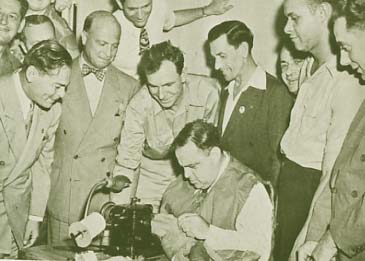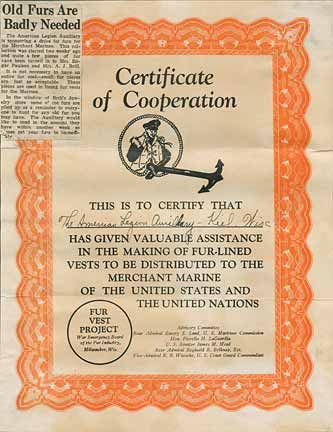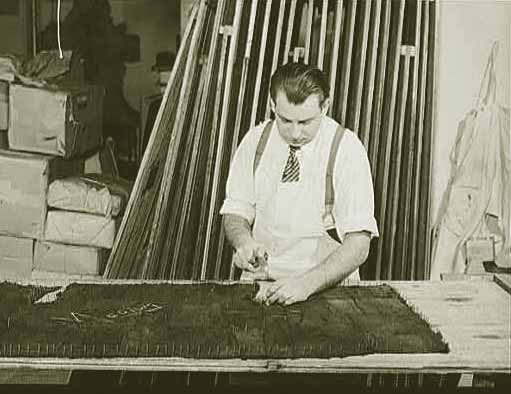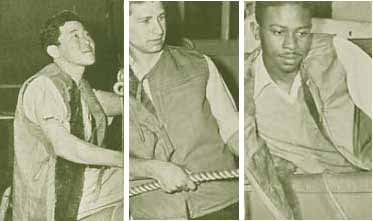The Fur Vest Project for Seamen during World War II
During World War II, every American -- from kindergartner to octogenarian -- was part of the "Homefront," and most did all they could for the war effort .
Boy Scouts held scrap drives, women rolled bandages, factory workers donated blood, and civilian air patrols patrolled the beaches. Scrap drives were extremely successful and were truly important for the war effort.
Thirty million pounds of scrap rubber, various metals, and kitchen fats were collected in just the first six months of the scrap drive in the state of Delaware. A 74 year-old resident of Wilmington, Delaware collected 12,088 tin cans from her own neighborhood. Her husband cut the tops and bottoms off the cans, and together they "Stomped on Tojo" to flatten the cans.
[If you're too young to know, rubber was recycled into new rubber products; various metals were processed to make guns, ships, tanks, and planes; kitchen fats were used to make explosives.]
The American fur industry also pitched in.
The War Emergency Board of the Fur Industry copied a project already underway in Canada: making and distributing fur-lined vests to Allied merchant mariners. Over 45,000 members of the International Fur Workers Union worked on their day off for the Fur Vest Project as their contribution to the war effort. Management of the fur industry contributed all the necessary materials and machines to convert the old furs into much needed vests.
Mayor Fiorello LaGuardia of New York City inaugurated the project on July 27, 1942. According to the New York Times, the Mayor sat down at a sewing machine and a fuse blew. Power was restored quickly, and the Mayor put in the first stitches in the first of 50,000 fur-lined vests.
Mayor Fiorello LaGuardia of New York City puts in
the first stitches into the first fur vestNationwide Appeal to Women
An undated Wisconsin newspaper article stated:
Old Furs Are Badly Needed
The American Legion Auxiliary is sponsoring a drive for furs for the Merchant Marines [sic]. this collection was started two weeks ago and quite a few pieces of fur have been turned in to Mrs. Edgar Paulsen and Mrs. A. J. Brill.It is not necessary to have an entire fur coat -- small fur pieces are just as acceptable. These pieces are used in ling fur vests for the Marines [sic].
In the window of Brill's Jewelry store some of the furs are piled up as a reminder to everyone to hunt for any old fur you may have. The Auxiliary would like to send in the amount they have within another week, so please get your furs in immediately.
Certificate awarded American Legion Auxiliary of
Kiel, Wisconsin to acknowledge their contributionDayton, Ohio held a “Fur Ball” at the Biltmore Hotel on September 28, 1942. Admission to the ball was donation of a piece of fur, and 500 attendees donated over 2,000 pieces of fur. Later the organizers received letters mailed throughout the world, thanking those who were kind enough to donate their time and their furs.
“The Fur Vests which you so kindly sent us were received in good order,” wrote R. E. Hudgins, “and on behalf of the Navy Armed Guard, Merchant Crew, and Officers of this vessel wish to express our gratitude and thanks for a splendid gift. They were our warmest friends on our recent trip to Russia.”
Donated furs were shipped to New York City, where they were sorted and cleaned in preparation for making the vest lining.
Receiving area for donated furs
Fur cutter fitting pieces for a vest
Furs were cleaned, disassembled, sewn together, dampened, nailed onto a board, and left to dry
Workers stitching heavy cotton exterior of vests
Fur worker modeling vest lined with jaguar
Completed vests packed for distribution
through seamen's centers and union halls
Merchant seamen wearing completed vests
Many seamen going to the Arctic or the North Atlantic were also issued fur-lined gloves.
Fur-lined gloves for mariners
Sources:
Delaware's role in World War II, 1940-1946. William H. Conner and Leon deValinger, Jr., Editors. Dover: Delaware Public Archives Commission, 1955
"Fur Jackets for Seamen, Seamen's Fur Vest Project: Fur Union Works Overtime to Make Vests for Soldiers," LIFE, Oct. 19, 1942
Fur vest project certificate of cooperation War Emergency Board of the Fur Industry, Manitowoc County (Wisconsin) / Kiel, Wisconsin
America from the Great Depression to World War II: Photographs from the FSA-OWI, 1935-1945 Marjory Collins, photographer, December 1942
American seamen: a review. New York: American Seamen's Friend Society, 1942
Guide to the International Fur and Leather Workers' Union. Records, 1913-1955
Home Sweet Home Front: Dayton During World War II10/26/07
www.USMM.org ©1998 - 2007. You may quote material on this web page as long as you cite American Merchant Marine at War, www.usmm.org as the source. You may not use more than a few lines without permission. If you see substantial portions of this page on the Internet or in published material please notify usmm.org @ comcast.net









